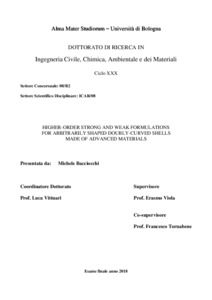Bacciocchi, Michele
(2018)
Higher-order Strong and Weak Formulations for Arbitrarily Shaped Doubly-Curved Shells Made of Advanced Materials, [Dissertation thesis], Alma Mater Studiorum Università di Bologna.
Dottorato di ricerca in
Ingegneria civile, chimica, ambientale e dei materiali, 30 Ciclo. DOI 10.6092/unibo/amsdottorato/8447.
Documenti full-text disponibili:
![[img]](http://amsdottorato.unibo.it/8447/1.hassmallThumbnailVersion/PhDThesis_MicheleBacciocchi.pdf)  Anteprima |
|
Documento PDF (English)
- Richiede un lettore di PDF come Xpdf o Adobe Acrobat Reader
Disponibile con Licenza: Salvo eventuali più ampie autorizzazioni dell'autore, la tesi può essere liberamente consultata e può essere effettuato il salvataggio e la stampa di una copia per fini strettamente personali di studio, di ricerca e di insegnamento, con espresso divieto di qualunque utilizzo direttamente o indirettamente commerciale. Ogni altro diritto sul materiale è riservato.
Download (15MB)
| Anteprima
|
Abstract
The well-known three-dimensional elasticity theory represents the most comprehensive approach to analyze the structural behavior of doubly-curved shells. However, this approach could be extremely burdensome in terms of calculation. Consequently, two-dimensional models are introduced to reduce the computations to obtain the solution. Among them, the Classical Shell Theory (CST) and the First-order Shear Deformation Theory (FSDT) are the most exploited approaches due to their simplicity. Nevertheless, their inadequacy could be evident if innovative and advanced mechanical constituents are considered. For this purpose, more refined approaches are developed. These models are known as Higher-order Structural Theories (HSDTs). This thesis aims to present a higher-order formulation able to model accurately the mechanical behavior of doubly-curved shells made of innovative and advanced materials. It is known that a closed-form solution cannot be obtained for these mathematical models. In other words, the governing equations cannot be solved analytically. Thus, a numerical method must be used to get an approximate solution. In general, two formulations of the same system of governing equations can be developed, which are the strong and weak formulations, respectively. If the strong formulation is solved, a numerical tool capable to approximate derivatives is required, since these equations are directly changed into a discrete system. On the other hand, a numerical approximation of integrals is needed when an equivalent integral formulation of lower order is solved, as in the case of the weak form. Therefore, two different numerical methods can be used to obtain the solution of these formulations. The Differential Quadrature (DQ) and Integral Quadrature (IQ) methods are discussed in this thesis. The accuracy, stability and reliability of the present formulations, as well as their superiority with respect to commercial Finite Element codes, are proven by a set of numerical analyses. An excellent agreement with the exact solutions is observed.
Abstract
The well-known three-dimensional elasticity theory represents the most comprehensive approach to analyze the structural behavior of doubly-curved shells. However, this approach could be extremely burdensome in terms of calculation. Consequently, two-dimensional models are introduced to reduce the computations to obtain the solution. Among them, the Classical Shell Theory (CST) and the First-order Shear Deformation Theory (FSDT) are the most exploited approaches due to their simplicity. Nevertheless, their inadequacy could be evident if innovative and advanced mechanical constituents are considered. For this purpose, more refined approaches are developed. These models are known as Higher-order Structural Theories (HSDTs). This thesis aims to present a higher-order formulation able to model accurately the mechanical behavior of doubly-curved shells made of innovative and advanced materials. It is known that a closed-form solution cannot be obtained for these mathematical models. In other words, the governing equations cannot be solved analytically. Thus, a numerical method must be used to get an approximate solution. In general, two formulations of the same system of governing equations can be developed, which are the strong and weak formulations, respectively. If the strong formulation is solved, a numerical tool capable to approximate derivatives is required, since these equations are directly changed into a discrete system. On the other hand, a numerical approximation of integrals is needed when an equivalent integral formulation of lower order is solved, as in the case of the weak form. Therefore, two different numerical methods can be used to obtain the solution of these formulations. The Differential Quadrature (DQ) and Integral Quadrature (IQ) methods are discussed in this thesis. The accuracy, stability and reliability of the present formulations, as well as their superiority with respect to commercial Finite Element codes, are proven by a set of numerical analyses. An excellent agreement with the exact solutions is observed.
Tipologia del documento
Tesi di dottorato
Autore
Bacciocchi, Michele
Supervisore
Co-supervisore
Dottorato di ricerca
Ciclo
30
Coordinatore
Settore disciplinare
Settore concorsuale
Parole chiave
Higher-order Shear Deformation Theories; Strong and weak formulations; Doubly-curved shell structures; Advanced materials
URN:NBN
DOI
10.6092/unibo/amsdottorato/8447
Data di discussione
10 Maggio 2018
URI
Altri metadati
Tipologia del documento
Tesi di dottorato
Autore
Bacciocchi, Michele
Supervisore
Co-supervisore
Dottorato di ricerca
Ciclo
30
Coordinatore
Settore disciplinare
Settore concorsuale
Parole chiave
Higher-order Shear Deformation Theories; Strong and weak formulations; Doubly-curved shell structures; Advanced materials
URN:NBN
DOI
10.6092/unibo/amsdottorato/8447
Data di discussione
10 Maggio 2018
URI
Statistica sui download
Gestione del documento:


 Login
Login
